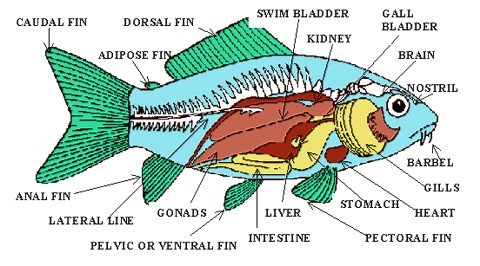How Carp Swim:
An Exploration of Carp Movement
Like all fish, carp use a variety of fins and internal buoyancy features to manoeuvre their ways through the rivers, lakes and ponds that they inhabit. European carp (Cyprinus carpio) way up to 80 pounds and can grow to over 5 feet in length. It takes muscle to move all of that carp! Specifically, carp utilize an intricate system of muscle blocks to power their fins.
 Anatomy of big carp
Anatomy of big carpPicture taken from http://www.freewebs.com/questforcarp/anatomyofcarp.htm
As these blocks of muscle, called myomeres, relax and contract alternately on each side of the fish, beginning at the head and ending at the tail, the various fins of the carp propel it forward. This occurs as multiple waves are created alongside of the fish. The end part of each individual wave creates thrust against the surrounding water and propels the fish into moving forwards through the water.
Let's examine the fins of the carp:
Pectoral Fins and Pelvic/ Ventral Fins:
- Are "paired" - one on each side of the body;
- Are used for both propulsion and stoppage;
- Used to control horizontal pitch levels (like airplane wings do);
- Used to attract mates;
- Used to startle adversaries;
- Provides stability (prevents rollovers);
- Provides accurate steering ability;
- Maintains positioning in fast currents;
- Can be used to "crawl" as well;
Caudle Fins:
- Singular;
- Is located at the end of the tail;
- Can be classified as pointed, round, truncated, forked, lunated, heterocercal or emarginated. The caudal fins of carp are forked;
- Is the main fin used for propulsion;
Dorsal Fins and Adipose Fins:
- Singular;
- Located in the central and rear regions of the back;
- Helps propel the fish;
- Provides precise forward and backward motion;
Anal Fins:
- Singular;
- Used in the same manners as dorsal fins are;
Swim Bladder:
- Located centrally inside of the carp;
- Has very flexible-walls;
- Is gas-filled;
- Controls buoyancy;
As a carp descends into deeper waters, exterior pressure increases and causes the gas of the swim bladder to be compressed. This causes the fish to sink. If the carp directs itself into shallower waters, exterior pressure decreases and the swim bladder expands. This causes the fish to float.
How to tell the difference between a male and female carp:
It's not really that easy to do - unless you know what to look for. Firstly, the male carp has well-developed muscles a around the pelvic fin; females do not. During spawning seasons, males will develop tubercles (white bumps) on their heads and gill plates. Also, females are significantly fatter during this time because they are carrying lots of eggs.
Locating Big Carp in the Spring
Carp Location in the Summertime
Finding Large Carp in the Cold Winter
Location of Most Carp in Autumn
The Case for Quality Carp Bait
Fishing Tactics for Snags & Trees
Boilie Placement on the Hair rig
Different types of carp rigs to use
A Carp's Digestive System in Detail
Ingredients used in Common Carp Baits
Common Baiting Tactics When Fishing
The Various Carp Bait used to Catch Bigger Carp
When to use Pop-ups or Bottom Bait for Carp Fishing
How to complete a Baiting Campaign on Lakes & Ponds
The Basic Carp Fishing Baits Used to Catch Large Carp
Fishing Tactics when Fishing for Carp during Long-stay Sessions